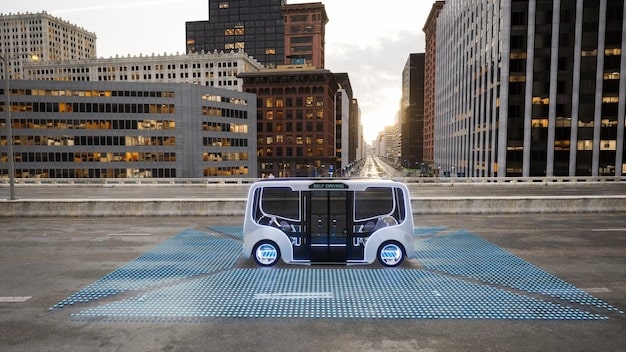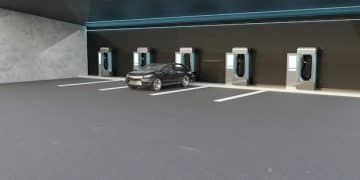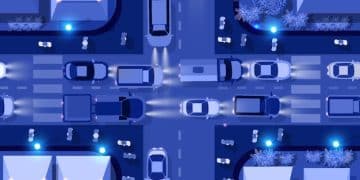Analyzing the Impact of Autonomous Vehicle Regulations in the US

Analyzing the Impact of New Regulations on Autonomous Vehicle Testing and Deployment in the US reveals significant shifts in the automotive industry, addressing safety concerns and technological advancements while shaping the future of autonomous vehicles in America.
The rise of autonomous vehicles promises to revolutionize transportation, but it also brings forth complex regulatory challenges. Analyzing the Impact of New Regulations on Autonomous Vehicle Testing and Deployment in the US is crucial for understanding the evolving landscape of this technology.
The Federal Regulatory Framework for Autonomous Vehicles
The federal government plays a critical role in setting the stage for autonomous vehicle development. Understanding this framework is key to Analyzing the Impact of New Regulations on Autonomous Vehicle Testing and Deployment in the US.
NHTSA’s Role in AV Regulation
The National Highway Traffic Safety Administration (NHTSA) is at the forefront of federal regulation. They are responsible for ensuring vehicle safety standards are met.
NHTSA’s approach includes establishing safety standards and issuing guidance for autonomous vehicle manufacturers. This guidance aims to promote innovation while maintaining high safety levels.
Federal Motor Vehicle Safety Standards (FMVSS)
FMVSS are crucial standards that all vehicles must meet. The applicability of these standards to autonomous vehicles is an evolving issue, requiring careful consideration.
- Existing standards may need to be adapted for vehicles without traditional driver controls.
- New standards might be required to address unique safety challenges posed by autonomous technology.
- Compliance with FMVSS is a key step in Analyzing the Impact of New Regulations on Autonomous Vehicle Testing and Deployment in the US.

Federal regulations provide a baseline, but the states play a significant role in implementing and shaping these rules to their local needs.
State-Level Regulations and Autonomous Vehicle Testing
While the federal government provides a foundation, states have the power to enact their own laws surrounding autonomous vehicles, affecting testing and deployment.
Varying State Approaches to AV Regulation
The approach to autonomous vehicle regulation varies significantly from state to state. Some states encourage testing and deployment, while others remain more cautious.
States like California and Arizona have been at the forefront of AV testing, establishing specific guidelines and permitting processes.
Permitting and Licensing Requirements
States typically require companies to obtain permits for testing autonomous vehicles on public roads. These permits often come with specific requirements.
- Reporting requirements include data on safety performance and incident reporting.
- Insurance requirements ensure adequate coverage in case of accidents.
- Geographic limitations can restrict testing to specific areas within the state.
Regulations significantly impact how companies can test their autonomous vehicles, with varying costs and timelines depending on the state.
Key Challenges in Autonomous Vehicle Regulation
Regulating autonomous vehicles comes with a unique set of challenges that necessitate a comprehensive and adaptive approach from policymakers.
Defining Liability in Autonomous Vehicle Accidents
Determining liability in accidents involving autonomous vehicles is a complex legal issue. Traditional concepts of fault may not directly apply.
Questions arise around whether the vehicle manufacturer, technology provider, or owner should be held liable in different scenarios.
Ensuring Cybersecurity and Data Privacy
Autonomous vehicles rely on sophisticated software and data processing, making them potential targets for cyberattacks. Data privacy is another significant concern.
- Regulations must address cybersecurity vulnerabilities to prevent unauthorized control of vehicles.
- Data privacy protections are needed to ensure that personal data collected by AVs are used responsibly.
- Addressing these concerns is a critical part of Analyzing the Impact of New Regulations on Autonomous Vehicle Testing and Deployment in the US.
These challenges are spurring innovative regulatory frameworks and discussions around the responsibilities of creators and users.
The Impact on Autonomous Vehicle Development and Deployment
Regulations have a tangible effect on the pace and direction of autonomous vehicle development and deployment, particularly concerning compliance costs and timelines.
Compliance Costs and Timelines
Complying with regulations can be costly and time-consuming for autonomous vehicle developers. These costs can impact small startups and large manufacturers alike.
Testing, data collection, and reporting requirements add to the overall cost of development. Delays in regulatory approval can also push back deployment timelines.
Encouraging Innovation While Ensuring Safety
Finding the right balance between encouraging innovation and ensuring safety is a central challenge for regulators. Overly strict regulations can stifle innovation.
Flexible and adaptive regulations that allow for experimentation while prioritizing safety are essential for the long-term success of the AV industry.

Striking this balance is critical for the future growth and widespread use of autonomous vehicles in the US.
Future Trends in Autonomous Vehicle Regulation
The field of autonomous vehicle regulation is constantly evolving to keep pace with technological advancements and societal needs.
Adaptive and Flexible Regulatory Frameworks
Future regulations are likely to become more adaptive and flexible to keep pace with rapid technological advancements. This will require ongoing dialogue between regulators and industry stakeholders.
Regulations may need to be revised and updated frequently to address new challenges and opportunities as they arise.
International Harmonization of Standards
Efforts may be made to harmonize standards internationally to facilitate cross-border testing and deployment of autonomous vehicles. This could simplify regulatory compliance for global manufacturers.
- Common safety standards could improve consumer confidence in autonomous technology.
- Streamlined regulations could reduce barriers to entry for new market participants.
- International cooperation would aid in Analyzing the Impact of New Regulations on Autonomous Vehicle Testing and Deployment in the US on a global scale.
The push for standardization aims to balance safety with progress.
The Role of Public Perception and Acceptance
Public perception plays a crucial role in shaping the regulatory landscape and the ultimate success of autonomous vehicles. Addressing concerns and building trust is essential.
Building Public Trust in Autonomous Technology
Public acceptance of autonomous vehicles depends on building trust in their safety and reliability. This requires transparency and open communication.
Demonstrating the benefits of AV technology, such as increased safety and accessibility, can help to alleviate public concerns.
Addressing Ethical Considerations
Ethical considerations, such as how autonomous vehicles should respond in unavoidable accident scenarios, also influence public perception and regulatory priorities.
Engaging with the public and addressing ethical concerns can shape regulatory frameworks that reflect societal values.
| Key Aspect | Brief Description |
|---|---|
| 🚦 Federal Oversight | NHTSA sets safety standards and issues guidance for AV manufacturers. |
| 🏛️ State Regulations | States vary in their AV regulations, impacting testing and deployment. |
| ⚖️ Liability Issues | Determining liability in AV accidents is legally complex. |
| 🛡️ Cybersecurity | Regulations must address cybersecurity vulnerabilities in AVs. |
Frequently Asked Questions
New regulations dictate specific safety standards and operational guidelines, impacting the cost, timeline, and geographical scope of testing activities for various vehicle manufacturers.
How do federal guidelines affect autonomous vehicle development?
Federal guidelines set a baseline, requiring adherence to safety standards while encouraging innovation through flexible frameworks.
What are the key state-level differences in governing autonomous vehicles?
State regulations vary significantly; some promote testing with permits and specific reporting requirements, while others maintain stricter oversight.
How is liability determined in accidents involving autonomous vehicles?
Liability is complex, involving considerations of vehicle manufacturers, technology providers, and owners based on the specifics of the accident.
What role does public perception play in autonomous vehicle deployment?
Public trust, shaped by transparency, safety demonstrations, and addressing ethical concerns, greatly influences the deployment and regulatory acceptance of AVs.
Conclusion
Analyzing the Impact of New Regulations on Autonomous Vehicle Testing and Deployment in the US reveals a complex interplay between innovation, safety, and public acceptance. As autonomous technology continues to evolve, so too will the regulatory environment, requiring ongoing dialogue and adaptation to ensure a future where AVs are both safe and widely accessible.





